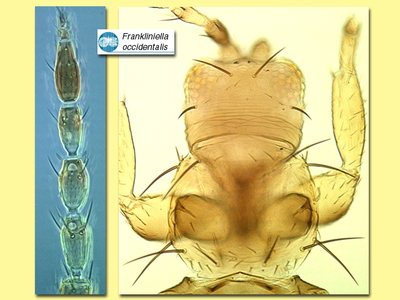Figures
Fig. 1 Antenna, head and pronotum
Fig. 2 Pronotum and abdomen (with cotton pollen)
Fig. 3 Fore wing
Fig. 4 Meso- and metanotum
Fig. 5 Tergite VIII with ctenidia and comb (female)
Fig. 6 Comb of tergite VIII
Species
Frankliniella occidentalis Pergande
Biology
The western flower thrips is an important pest of a wide range of greenhouse and flower crops, both through its feeding damage and as a vector of tomato spotted wilt virus. The adults can also, under some circumstances, be important predators of plant-feeding mites. Curiously, although highly polyphagous, this species is not yet known to breed on any Australian native plant, but regular importation of new populations from many different countries could change this situation.
Distribution
Originally from western U.S.A., this species is now worldwide in greenhouses, although it is not found in tropical countries except at high altitudes, because reproduction seems to fail at temperatures above about 32 degrees.
Recognition
Moderately large thrips, varying in colour from yellow to dark brown, but usually yellow with brown markings medially on the tergites, and all major setae dark; antennal segment I pale, II dark, III-V bicoloured, VI-VIII brown; forewings pale to very weakly shaded. Antennae 8-segmented, sense cones on III & IV forked. Head with one pair of setae in front of first ocellus, one pair on anterior margins of ocellar triangle; one pair of postocular setae long. Pronotum with 2 pairs of long setae on anterior margin, 2 pairs of long posteroangulars, and one pair posteromedially. Metanotum with median setae arising at anterior margin (or very close to it); campaniform sensilla usually present. Forewing with both longitudinal veins bearing complete row of setae. Tergites V-VIII each with a ctenidium laterally, on VIII anterolateral to spiracle; tergite VIII posteromarginal comb variable, usually comprising slender microtrichia each on a broad triangular base, but frequently varying in size. Sternites with no discal setae. Male sternites III-VII with transverse glandular area.
Related species
Almost 160 species are currently recognised in this genus, more than 150 of which are from the New World (Nakahara, 1997). The most closely related species to the western flower thrips is the European species, F. intonsa, a species with short postocular setae, and F. panamensis that is very dark in colour and with the comb on tergite VIII longer and more regular.







